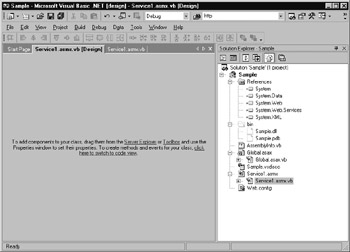Taking a Quick Look at a Web Service s Support Files
|
|
Taking a Quick Look at a Web Service’s Support Files
Behind the scenes, the .NET environment makes use of several support files that Visual Studio .NET automatically generates each time you create a web service. To view a listing of the various files within Visual Studio .NET, you can use the Solution Explorer, as shown in Figure 12.1.

Figure 12.1: Using the Visual Studio .NET Solution Explorer to display a web service’s support files
To display the support files within Visual Studio .NET, perform these steps:
-
Select the View menu Solution Explorer option. Visual Studio .NET will display the Solution Explorer window.
-
Within the Solution Explorer window, click the View All Files button.
Table 12.1 briefly describes the purpose of each support file. If you double-click a specific file’s entry, Visual Studio .NET will open the file’s contents for editing. Figure 12.2, for example, shows the contents of the AssemblyInfo.vb file, the contents of which this book will discuss next.
| File(s) | Purpose |
|---|---|
| AssemblyInfo.vb (or .cs) | Contains entries programmers can use to customize the assembly, which is the file the .NET environment uses to package programs or web services. |
| Global.asax, Global.asax.vb (or .cs), Global.asax.resx | Contains program statements developers can customize to specify the processing the web service performs each time the server starts or terminates the service, or when a client program makes a request of the service. |
| Service1.asmx, Service1.asmx.vb (or .cs), Service1.asmx.resx | Contains the program source code that implements the web service, and information about the resources the service requires. |
| Web.config | Contains XML-based entries a developer can use to customize application settings, such as authentication and authorization policies, debug operations, support for tracing, or application- and session-object settings. |
| .webinfo | Specifies the web service’s URL. If you move the web service, you must edit the file’s contents to change the URL. |
| .vsdisco | Contains XML-based entries that developers can use to control the processing that other programs can perform to discover information about the web service. |
|
|
EAN: 2147483647
Pages: 161
- Enterprise Application Integration: New Solutions for a Solved Problem or a Challenging Research Field?
- The Effects of an Enterprise Resource Planning System (ERP) Implementation on Job Characteristics – A Study using the Hackman and Oldham Job Characteristics Model
- Context Management of ERP Processes in Virtual Communities
- Distributed Data Warehouse for Geo-spatial Services
- Relevance and Micro-Relevance for the Professional as Determinants of IT-Diffusion and IT-Use in Healthcare